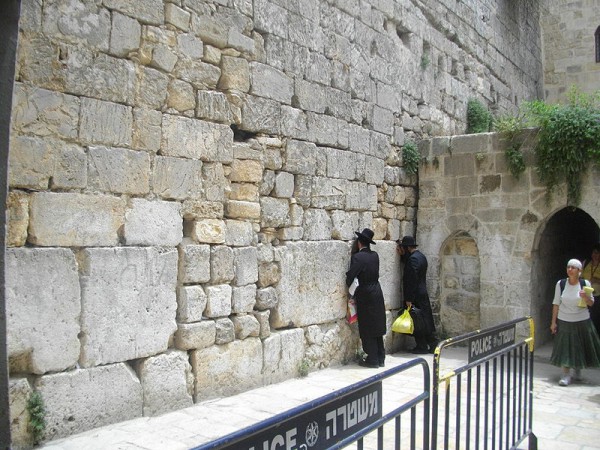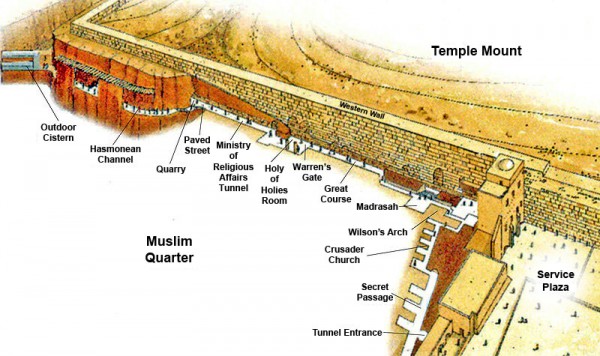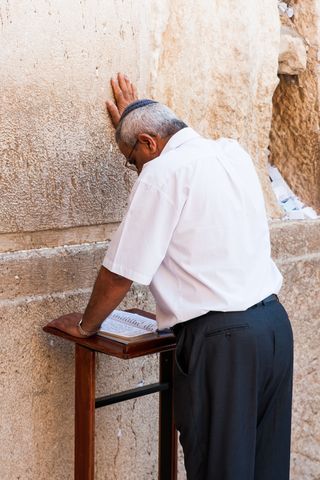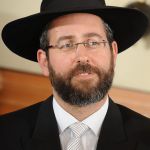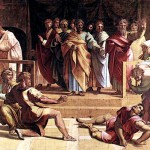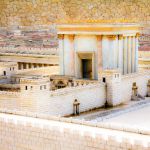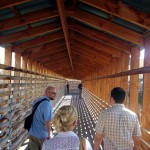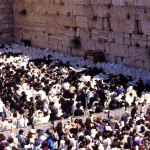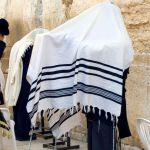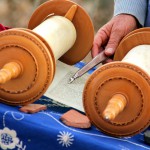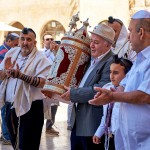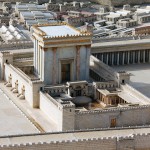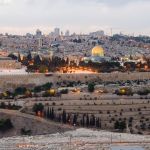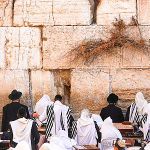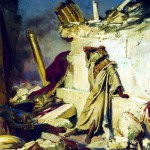“Look! There he stands behind our wall, gazing through the windows, peering through the lattice.” (Song of Songs 2:9)
Today, because the Third Temple has not yet been rebuilt, the Western Wall is considered by many to be Judaism’s most sacred accessible site.
The Wall was not a part of the Temple itself but rather the retaining wall that surrounded the Temple Mount. It was built by King Herod when he expanded the Second Temple and the Temple Mount platform.
At all hours of the day and night, a steady stream of worshipers and tourists pour into this holy place that is located in the Old City of Jerusalem.
It is much more than a national site; it is a huge open-air synagogue where daily and Sabbath prayer services are held, as well as special events, such as Bar and Bat Mitzvahs.
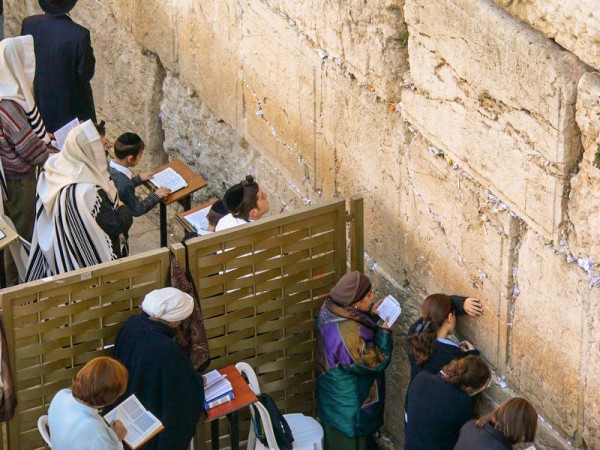
The Western Wall Plaza is separated in two sides: one side is for women, and one for men, just like in an Orthodox Jewish synagogue.
The Divine Presence
Many people report that they have profoundly experienced the presence of God at the Western Wall.
Zalman Shazar, who served as the president of Israel from 1963 to 1973, described a similar sensation when he came to the Wall during his first visit to the Land of Israel in 1911.
“You will go down through the narrow alleys of ancient Jerusalem and arrive at the Wall and stand there. Then you will not only see with your eyes but you will also feel with your entire being the single eternity in our past … And when your feet enter the courtyard of the Wall, here you feel and experience the re-weaving of your soul into the eternal fabric of 2,000 years …
“Into the space at this remnant of the Wall the sighs from all the ends of the earth and all eras penetrate … The Wall does not differentiate between lands and eras. The tears have all flowed from the hearts of one people, they have all come from one source and they will all pray to One.” (HaAretz)
Rabbi Jonathan, who witnessed the Roman conquest of Jerusalem in AD 66–70, wrote that the Shekinah glory of God did indeed leave the Temple in AD 66 and moved to the Mount of Olives.
He said that the Lord’s presence “abode on the Mount of Olives hoping that Israel would repent, but they did not; while a Bet Kol [a supernatural voice] issued forth announcing, ‘Return, O backsliding children [Jeremiah 3:14]. Return unto Me, and I will return unto you [Malachi 3:7].’ When they did not repent, it said, ‘I will return to My place [Hosea 5:15].’” (Midrash Rabbah, Lamentations 2:11)
Yet, God’s Presence is nevertheless perceived to have remained here after the destruction of the Temple.
It is customary, therefore, for people—even high-profile dignitaries visiting Israel—to place prayers written on slips of paper between the eroded joints, cracks, and crevices of the ancient stones of the Wall.
So many prayers are left here that they must be collected twice a year.
According to Jewish law, anything with the name of God on it must be treated with the same respect that a scroll of Torah or a book containing the name of God would receive.
Since these prayer slips cannot be thrown away, when they are collected, they are buried in the Jewish cemetery on the nearby Mount of Olives.
More than Meets the Eye
Most of the Western Wall, which runs along the western portion of the Temple Mount, is concealed behind existing structures.
It actually stretches some 488 meters (1,600 feet).
Of the above-ground sections of the Wall, the most famous area is the Kotel Plaza, located in the Jewish Quarter of the Old City.
Only 28 of its stone rows are above ground. Seventeen layers lay below the surface.
Because the plaza area in front of the Wall measures 57 meters (187 feet) long and 37.5 meters (123 feet) wide, thousands can gather here for prayer.
Every year, in fact, the Kotel Plaza is the number one tourist destination in Israel; millions from all over the world are drawn to this place to pray and recite Scripture from the Book of Psalms.
Large crowds visit on the Jewish holidays, such as on Tisha B’Av, when the destruction of the First and Second Temples are remembered, and mourners recite the Book of Lamentations while seated on the ground.
Another exposed section of the Western Wall is the HaKotel HaKatan (The Small Wall) in the Muslim Quarter.
Although only the two lowest levels of bricks belong to the Second Temple period, this eight meter (25 foot) section is also holy to the Jewish People because of its proximity to the spot where the Holy of Holies in the Second Temple was located.
In fact, it is actually closer to that spot than the Kotel Plaza.
It is not as crowded as the larger plaza section and unlike at the Kotel, men and women can pray here side by side.

Robinson’s Arch, which once supported a monumental staircase to the Temple Mount, is located close to the southwestern corner of the Mount. The people walking near the bottom middle of the photo help to provide a sense of the scale of these toppled stones.
Yet another above-ground section is in the southern part of the Western Wall.
In 1968, Benjamin Mazar began excavating this section, which lay under the heap of stone fragments left by the Romans.
These mammoth stones had been thrown down by the Roman soldiers from the Temple Mount when they destroyed the Temple, smashing many of the large slab paving stones and crushing buildings located near the wall.
Here on this ancient commercial thoroughfare, Jewish pilgrims coming to the Temple Mount once shopped.
The Western Wall Tunnel
While the full length of the Western Wall is not exposed above ground, there is a tunnel in which the original street level can be viewed.
Although this tunnel was excavated by Israel between 1970 and 1988, and opened in 1996 to the public, the excavations continue and long hidden secrets are still being revealed.
“The most important events in the history of the Jewish people happened right here,” said California venture capitalist Isaac Applbaum, a board member of The Western Wall Heritage Foundation.
“I actually feel my ancestry, I feel my history, I feel my religion. My great-great-great-great grandfather worked here, toiled here, found his religion here. It’s like coming home,” he said. (Business Insider)
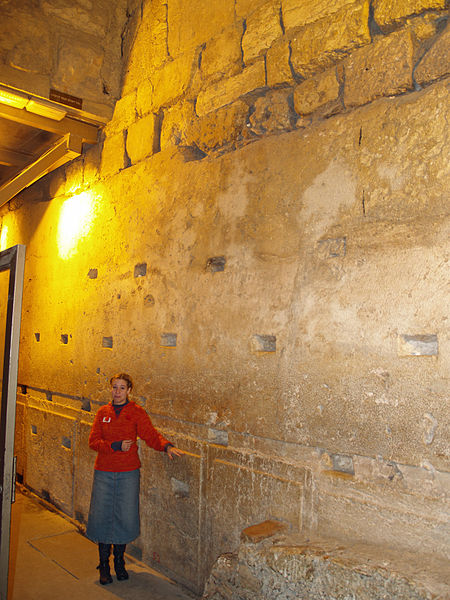
The Western Stone is currently the largest stone visible in the Western Wall Tunnel. At an estimated 570 tons, it is not only one of the heaviest objects ever lifted without machinery, it is also one of the largest known building blocks in the world.
The Western Wall Tunnel (Minheret HaKotel) runs the full length of the wall beneath residential buildings in the Old City of Jerusalem, allowing access to an additional 485 meters (1,591 ft) of the wall.
While the stones above ground are scarred with bullet holes and worn by weather, here the stones are practically perfect.
The finely cut stone blocks called “Herodian ashlars” have two inch margins that run around a flat raised boss. (These margins are visible in the above photo.)
In the tunnels are First and Second Temple era mikva’ot (ritual baths). There are also halls that are large enough to host events such as Bar Mitzvahs. Here you can also walk on a portion of a street where Yeshua may have walked with His talmudim (disciples).
Here is also the place that is traditionally considered to be closest to the actual location of the Holy of Holies. This section of the tunnel is open for Jewish worship.
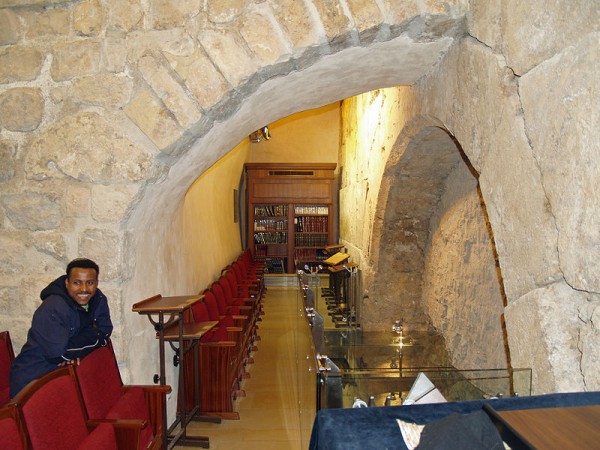
Western Wall Tunnel: some believe that before the Jewish People began praying at the Kotel Plaza, they prayed inside Warren’s Gate, which is now sealed. For hundreds of years, Warren’s Gate was a synagogue called The Cave (Temple Mount).
The Sacredness of the Western Wall
Although the Western Wall is important by virtue of its proximity to the place where the Holy of Holies was located on the Temple Mount, for many, it has become more important than the Mount itself.
Part of the reason for this may be the fact that the Muslim Waqf, which was given authority over the Mount by Israel, does not allow non-Muslim prayer on the Mount.
Furthermore, Jewish visits are frequently blocked by Waqf authorities, who are backed by Temple Mount police.
Another reason could be that many Jews and Christians report having visions or deeply experiencing the Ruach HaKodesh (Holy Spirit) at the Western Wall.
One Jewish teenager described to Bibles For Israel an experience that he had before he came to faith in Yeshua through the Messianic prophecies:
“This beautiful spiritual force circled around my body. I didn’t know God, but I knew it was God, and I believe now that God’s Presence is at the Temple Mount and the Kotel,” he said.
Although the Temple Mount might be seen as a political liability today, and many are satisfied that the Divine Presence stills abides in the Western Wall, the fact is, the Lord has chosen the Temple Mount as the place for the Jewish People to seek Him.
“But you are to seek the place the LORD your God will choose from among all your tribes to put His Name there for His dwelling. To that place you must go.” (Deuteronomy 12:5)
Though it is true that we have access to the Divine Presence through Yeshua, it is also true that in the last days, the Third Temple will be built in Jerusalem.
“In the last days, the mountain of the Lord’s Temple will be established as the highest of the mountains; it will be exalted above the hills, and all nations will stream to it. Many peoples will come and say, ‘Come, let us go up to the mountain of the Lord, to the Temple of the God of Jacob.’” (Isaiah 2:2–3)
The crowds that are drawn to the Western Wall in this generation perhaps foreshadow the time in the near future when the nations will come to the Temple to seek the Lord.
Today, the Divine Presence at the Wall is hidden from view. But the day is coming, and is not too far away, when the Divine Presence will appear with undeniable power and glory in the Third Temple.
“I saw the glory of the God of Israel coming from the east. His voice was like the roar of rushing waters, and the land was radiant with His glory. … The glory of the Lord entered the Temple through the gate facing east… and the glory of the Lord filled the Temple.” (Ezekiel 43:1–5)







